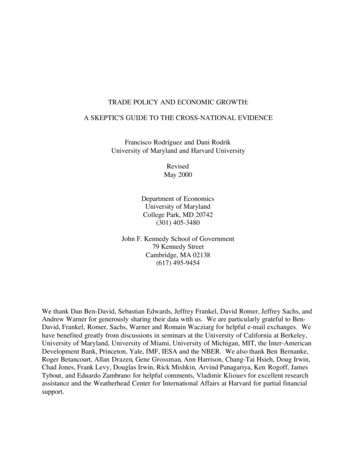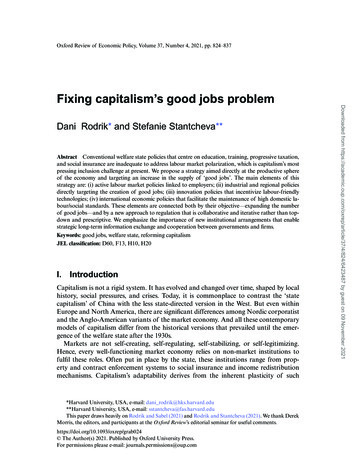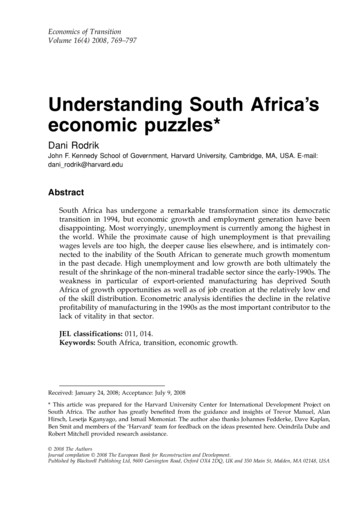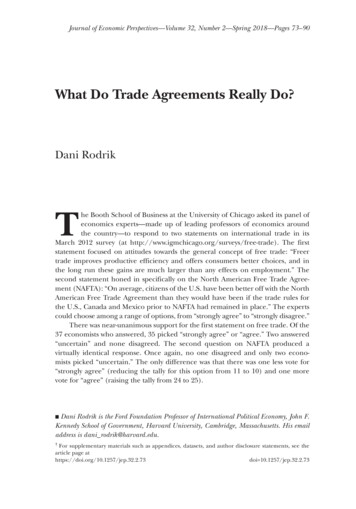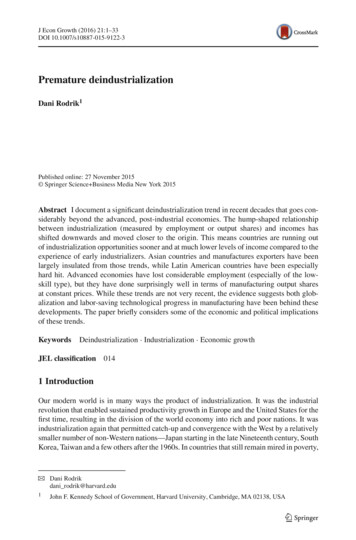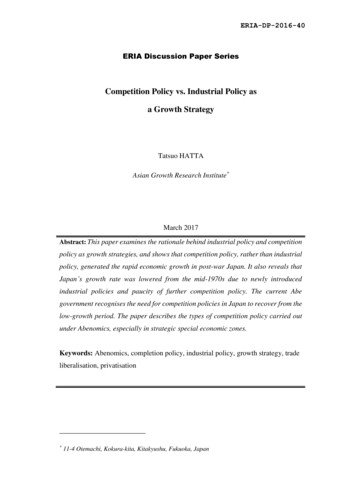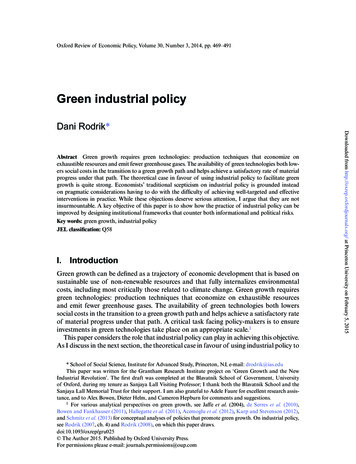
Transcription
Oxford Review of Economic Policy, Volume 30, Number 3, 2014, pp. 469–491Green industrial policyAbstract Green growth requires green technologies: production techniques that economize onexhaustible resources and emit fewer greenhouse gases. The availability of green technologies both lowers social costs in the transition to a green growth path and helps achieve a satisfactory rate of materialprogress under that path. The theoretical case in favour of using industrial policy to facilitate greengrowth is quite strong. Economists’ traditional scepticism on industrial policy is grounded insteadon pragmatic considerations having to do with the difficulty of achieving well-targeted and effectiveinterventions in practice. While these objections deserve serious attention, I argue that they are notinsurmountable. A key objective of this paper is to show how the practice of industrial policy can beimproved by designing institutional frameworks that counter both informational and political risks.Key words: green growth, industrial policyJEL classification: Q58I.IntroductionGreen growth can be defined as a trajectory of economic development that is based onsustainable use of non-renewable resources and that fully internalizes environmentalcosts, including most critically those related to climate change. Green growth requiresgreen technologies: production techniques that economize on exhaustible resourcesand emit fewer greenhouse gases. The availability of green technologies both lowerssocial costs in the transition to a green growth path and helps achieve a satisfactory rateof material progress under that path. A critical task facing policy-makers is to ensureinvestments in green technologies take place on an appropriate scale.1This paper considers the role that industrial policy can play in achieving this objective.As I discuss in the next section, the theoretical case in favour of using industrial policy to* School of Social Science, Institute for Advanced Study, Princeton, NJ, e-mail: drodrik@ias.eduThis paper was written for the Grantham Research Institute project on ‘Green Growth and the NewIndustrial Revolution’. The first draft was completed at the Blavatnik School of Government, Universityof Oxford, during my tenure as Sanjaya Lall Visiting Professor; I thank both the Blavatnik School and theSanjaya Lall Memorial Trust for their support. I am also grateful to Adele Faure for excellent research assistance, and to Alex Bowen, Dieter Helm, and Cameron Hepburn for comments and suggestions.1 For various analytical perspectives on green growth, see Jaffe et al. (2004), de Serres et al. (2010),Bowen and Fankhauser (2011), Hallegatte et al. (2011), Acemoglu et al. (2012), Karp and Stevenson (2012),and Schmitz et al. (2013) for conceptual analyses of policies that promote green growth. On industrial policy,see Rodrik (2007, ch. 4) and Rodrik (2008), on which this paper draws.doi:10.1093/oxrep/gru025 The Author 2015. Published by Oxford University Press.For permissions please e-mail: journals.permissions@oup.comDownloaded from http://oxrep.oxfordjournals.org/ at Princeton University on February 5, 2015Dani Rodrik*
470Dani RodrikII. The case for green industrial policy: strong in theory,ambiguous in practiceIf markets worked well, natural and environmental resources were priced appropriately at full social marginal costs, and technological benefits were fully internalized bythose who undertook R&D, we could in principle leave such investment decisions in thehands of entrepreneurs, corporations, and financial markets. But there are three sets ofconsiderations that drive a wedge between private and social returns to investment ingreen technologies.First, the development of new technologies generates positive spillovers that are notfully captured by the original investors. These may take the form of cross-firm externalities, industry-wide learning, skill development, or agglomeration effects. Such ‘marketfailures’ exist in general for all kinds of new technologies, whether they are of the greenor dirty kind. However, their novelty, their highly experimental nature, and the substantial risks involved for pioneer entrepreneurs suggest green technologies may be particularly prone to these failures.An additional reason why green technologies may need to be publicly subsidized isthat carbon (which I use as shorthand for greenhouse gases (GHGs) generally) is greatlymispriced. This is a second-best reason for government intervention in support of greentechnologies. The presence of subsidies on fossil fuels and the failure to implement taxesor controls that would internalize the risks of climate change result in the user cost ofcarbon falling substantially below the level that is appropriate from a long-term societal perspective.2 This means that the private return to green technologies lies significantly below the social return, even when we ignore the traditional R&D spillovers.3 Put2 The IMF (2013, pp. 13–14) estimates that effective subsidies on energy amount to 1.9 trillion (or 2.5per cent of world GDP). The bulk of this subsidy arises from the absence of taxes needed to internalize thenegative climate and health externalities generated by burning fossil fuels.3 On the empirical relation between fuel prices and carbon-saving innovation in the auto industry, seeAghion et al. (2012). This second-best role for policies supporting green technologies is also emphasized byJaffe et al. (2004). Bosetti et al. (2010) consider quantitatively the role of innovation policies to substitute forexplicit carbon control policies and conclude that they are not sufficient, even under optimistic assumptions,to stabilize GHG concentrations and temperatures.Downloaded from http://oxrep.oxfordjournals.org/ at Princeton University on February 5, 2015facilitate green growth is quite strong. Economists’ traditional scepticism on industrialpolicy is grounded instead on pragmatic considerations having to do with the difficultyof achieving well-targeted and effective interventions in practice. While these objectionsdeserve serious attention, I argue that they are not insurmountable. A key objective ofthis paper is to show how the practice of industrial policy can be improved by designinginstitutional frameworks that counter both informational and political risks.The outline of the paper is as follows. In section II, I review the theoretical case for greenindustrial poIicy as well as the arguments against. Next, I provide a brief overview of therange of green industrial policies already in place in the United States, Germany, China,and Japan (section III). I then discuss a specific instance of industrial support that endedup in failure (the case of Solyndra), and argue that the real lessons are quite different fromthose that are conventionally drawn (section IV). In section V I provide some general guidelines about the design of industrial policy. In section VI I offer some concluding remarks.
Green industrial policy4714 An important exception that does not take away the main point is the raising of tariffs on imports ofChinese solar panels in the US and Europe (Deutch and Steinfeld, 2013; Freund, 2013). On the potentialconflict between green industrial policy and trade laws see Wu and Salzman (2013).Downloaded from http://oxrep.oxfordjournals.org/ at Princeton University on February 5, 2015differently, the case for subsidizing green technologies is broader and stronger than thegeneral case for alleviating R&D-related market failures: the under-pricing of carbongenerates an independent motive for industrial policy in this area.R&D externalities and carbon under-pricing provide mutually reinforcing reasonsfor why the world would be collectively better off if governments nurtured and supported green technologies. However, what is true for the world as a whole need not betrue for national governments interested in maximizing domestic welfare. The benefitsof carbon abatement represent the archetypal global public good, generating strongincentives for individual countries to free ride on others’ efforts. In a world where governments do not internalize the global benefits of carbon taxes/controls in the firstplace, it is unlikely that they will place much value on green technologies on account ofthese technologies’ impact on the global stock of GHGs. Similarly, R&D externalitiesfrom the development of new green technologies are in many instances global ratherthan national. Learning sometimes spills over quickly across national borders to firmslocated in other countries. To the extent that governments anticipate (or fear) suchspillovers, their incentive to invest in green technologies is further diluted.Yet, as I document in the next section, government support for green industries isrampant, both in advanced and emerging economies. Often, the motive seems to be togive the domestic industry a leg up in global competition. Under certain conditions,this may be a sensible strategy from a national standpoint—although the global implications (absent the two considerations above) are often ambiguous or negative. Forexample, a first-mover advantage in certain technologies can tilt the future path oftechnological development in a direction that is closer to a country’s initial comparative advantage, providing long-term terms-of-trade benefits to the home economy. Or,subsidizing investment in home technologies can shift rents from foreign producers inimperfectly competitive industries. Such competitive motives are the third set of considerations that drive a wedge between private and social optimality in markets for greentechnologies.Normally, we consider these competitive motives to be of the beggar-thy-neighbourtype. Terms-of-trade or rent-shifting effects are zero-sum from a global standpoint, andany resources invested in generating those national gains come at the cost of globallosses. However, in the highly second-best context of green growth, national effortsto boost domestic green industries can serve to offset the two sets of market failuresdiscussed above, even if the motives are narrowly national and carry beggar-thy-neighbour connotations. When cross-border spillovers militate against taxing carbon andsubsidizing technological development in clean industries, boosting green industriesfor competitive reasons is largely a good thing, not a bad thing. However, by the sametoken, when these national strategies take the form not of subsidizing domestic industries but of taxing or restricting market access to foreign green industries, they have tobe considered triply damaging. Luckily, as the overview in the next section shows, traderestrictions have so far played a small role relative to subsidies to domestic industry.4Economists traditionally exhibit scepticism—if not outright hostility—towardsindustrial policies. But these considerations suggest that they should look kindly at
472Dani RodrikDownloaded from http://oxrep.oxfordjournals.org/ at Princeton University on February 5, 2015industrial policies geared towards green technologies. Industrial policies have an indispensable role in putting the global economy on a green growth path. The imperativeof addressing climate change places industrial policy squarely on the policy agenda ofgovernments.The trouble is that industrial policy has a very chequered history. While it hasundoubtedly worked in many places in East Asia to foster structural change and newindustries (Japan, South Korea, Taiwan, China), in advanced countries and many developing countries it remains synonymous with white elephants, rent-seeking, and goodmoney spent after bad. In truth, such caricatures are wildly at variance with the actualcontribution industrial policy has made to technological development in the UnitedStates and Europe. Any critic of industrial policy can identify a string of expensive failures: the Concorde, national champions in autos and aviation, and so on. Yet it is alsothe case that government support has played a crucial role in the development of keyindustries in the US such as Silicon Valley or biotechnology—a fact that is acknowledged by industrial policy’s critics (e.g. Lerner, 2012) as well as its supporters (e.g. Blockand Keller, 2011). Mazzucato (2013) has recently argued that every key technology inthe iPhone—the touchscreen display, the GPS, voice-activated assistant—has benefitedfrom public funds.Neither does infant-industry promotion in developing nations quite deserve its negative reputation in academic circles. Scores of developing countries registered productivity growth rates under import-substitution policies that far exceed those they haveexperienced in recent decades (Rodrik, 1999). And virtually every major non-traditionalexport product in Latin America, from salmon in Chile to aircraft in Brazil, owes itsexistence to industrial policy of some sort. Nevertheless, making industrial policy workis a challenge, and one that needs to be confronted head on if green industries are toplay their proper role in green growth.The case against industrial policy comes in two forms. The first counter-argument isthat governments do not have the information needed to make the right choices as towhich firms or industries to support. Usually presented with the formulaic statement‘government cannot pick winners’, this suggests governments are likely to make lotsof mistakes and hence waste considerable resources, even when they are well intentioned. The second counter-argument is that once governments are in the business ofsupporting this or that industry, they invite rent-seeking and political manipulationby well-connected firms and lobbyists. Industrial policy becomes driven by politicalrather than economic motives. In the United States, the case of Solyndra—a solar cellmanufacturer that folded after having received more than half a billion dollars in loanguarantees from the US government—provides a recent illustration where both failureswere apparently in play. I review and discuss the Solyndra case later in the paper.I contend in this paper that the first of these arguments—about lack of omniscience—is largely irrelevant, while the second—about political influence—can be overcome withappropriate institutional design. Good industrial policy does not rely on government’somniscience or ability to pick winners. Mistakes are an inevitable and necessary partof a well-designed industrial policy programme; in fact, too few mistakes are a sign ofunderperformance. What is needed, instead, is a set of mechanisms that recognizes errorsand revises policies accordingly. This is a much less demanding requirement than thatof picking winners. The chief argument of this paper is that an explicit industrial policythat is carried out self-consciously and designed with pitfalls in mind is more likely to
Green industrial policy473overcome the typical informational and political barriers than one that is implemented,as is so often the case, surreptitiously and under the radar screen.III. A snapshot of green industrial policies in selectedcountriesDownloaded from http://oxrep.oxfordjournals.org/ at Princeton University on February 5, 2015It is generally accepted that governments have been timid in reducing GHG emissions andinstituting other steps that would avert catastrophic climate change. Yet there has beenplenty of government activism in the area of ‘green growth’. Look around most developedand emerging market economies and you will find a bewildering array of government initiatives designed to encourage renewable energy use and stimulate green technology investment. Even though full pricing of carbon would be a far better way to address climatechange, it appears most governments would rather deal with the problem through subsidiesand regulations that increase the profitability of investments in renewable energy sources.As Steer (2013) points out, the concept of ‘green growth’ has spawned the idea thatpolicies that promote environmentally friendly technologies are actually advantageousfrom a national standpoint. Such policies are viewed as providing broad-based technological capabilities, a head-start, and, in new industries, competitive advantage in globalmarkets, and well-paying jobs. In other words, green growth has become ‘sexy’. Steer(2013) notes that more than 50 developing countries have now instituted practices suchas feed-in tariffs or renewable energy standards to foster green technologies—costlypolicies ‘that at first sight seem not to be in their country’s narrow interest’ (Steer, 2013,p. 18). Fankhauser et al. (2012) review what they call the ‘green race’ and provide anempirical analysis of the determinants of relative success across countries.It would take too much space to cover the full range of these policies. Here I providea quick overview of existing programmes in two advanced countries and two emergingmarket economies: the United States, Germany, China, and India. The relevant information is summarized in Tables 1–4. The tables list for each of the countries the keypieces of legislation, policy tools used, and illustrative programmes. The informationhas been compiled from national and international sources.Among the countries shown, Germany and China have the most aggressive policies.But even the others make use of a wide range of policy instruments. While some of theinstruments listed do not qualify as industrial policies (e.g. cap-and-trade policies, mandated energy efficiency standards), many others clearly are (R&D grants, governmentprocurement, subsidized loans and loan guarantees, direct subsidies).In addition to a 40 per cent GHG reduction target, Germany has an extensive arrayof initiatives. These include R&D support of several billions of euros (focusing on windenergy, PV renewable energy systems, integration of renewable energies, geothermal,solar thermal power plants, and low-temperature solar thermal energy installations),long-term low-interest loans (for solar PV, biomass, wind energy, hydropower, or geothermal, and electricity or heat from other renewables), an energy and climate fund(spent on various support programmes relating to energy efficiency, renewable energy,energy storage and grid technology, energy-efficient renovation, national and international climate protection, as well as electro-mobility), a climate protection initiative(with projects in areas such as refrigeration technology and biomass research), and a
474Dani RodrikTable 1: United States’ green growth policiesImportant laws and policiesClean Air Act; National Energy Conservation Policy Act; Energy Policy Act of 2005Energy Independence and Security Act of 2007; Energy Improvement and Extension Act of 2008Food, Conservation, and Energy Act (2008 Farm Bill)Executive Orders 13423 and 13514American Recovery and Reinvestment Act of 2009: over 80 billion to support clean energy R&D anddeploymentEnvironmental Protection Agency (EPA)’s Final Greenhouse Gas Tailoring Rule (2010) and proposed CarbonPollution Standard for New Power PlantsSignificant government programmesFederalDepartment of Energy (DOE)’s Office of Energy Efficiency and Renewable Energy programmes, including: Wind(including Wind Powering America), Solar (including SunShot Initiative), Bioenergy, Geothermal Technology,Hydrogen & Fuel Cell Technologies, Vehicle Technologies, Buildings, Energy Efficiency and Conservation BlockGrant, and Weatherization and Intergovernmental programmesRenewable Fuel Standard ProgramDOE Section 1703 and Advanced Technology Vehicles Manufacturing Loan ProgramsEnergy StarFederal support to states for renewable energy and energy efficiency programmes: DOE’s State Energy andEPA’s State Climate and Energy Partnership ProgramsRenewable portfolio standards (RPS) in a majority of states (at least 33 have RPS standards or goals in place)California cap-and-trade programme created regulations and market mechanisms to reduce the state’s GHGemissions to 1990 levels by 2020, with mandatory caps beginning for significant emissions sourcesRegional Greenhouse Gas Initiative (RGGI): mandatory cap-and-trade programme for fossil-fuel-fired powerplants, consisting of Connecticut, Delaware, Maine, Maryland, Massachusetts, New Hampshire, New York,Rhode Island, and Vermont.California’s Alternative and Renewable Fuel and Vehicle Technology Program; California Solar Initiative, GoSolar CaliforniaNew York State Energy Plan; Western Climate InitiativeDownloaded from http://oxrep.oxfordjournals.org/ at Princeton University on February 5, 2015Tools usedFederal Production Tax Credit (PTC; about to expire) and Investment Tax Credit (ITC; or direct grants): the PTCreduces the federal income taxes of renewable energy facility owners per kWh produced, and ITC reducesfederal income taxes for investments in renewable energy projectsTax credits for energy efficiency upgrades (both for commercial entities and individuals) and purchases ofelectric vehiclesEPA standards for GHG emissions from mobile and stationary sources under the Clean Air Act (in process ofbeing implemented but facing legal challenges)Loan guarantees and concessional lending for projects that reduce GHG emissionsGrant funding for R&D in renewable energy, energy efficiency, carbon capture and storage, electric vehicle, fuelcell technologiesGrants to support training of ‘green-collar’ workersGovernment procurement policies (e.g. purchasing energy-efficient vehicles)Renewable fuel standards, fuel efficiency standards (Corporate Average Fuel Economy, or ‘CAFE’, standards),and a ‘gas guzzler tax’ on new carsAccelerated deductions for renewable energy investmentsEnergy efficient mortgagesQualified Energy Conservation BondsManufacturing Tax Credits for manufacturers of energy efficient appliances; tax credits for gas stations/fuellingcentres that install alternative fuel pumps; tax credits for alternative fuelsFederal appliance standardsCap-and-trade (at the state level)State-level Renewable Portfolio Standards
Green industrial policy475IV.Solyndra: economics and politicsIn May 2010, President Obama visited a company in Fremont, California, praising it as a‘symbol of progress’. The company was Solyndra, a solar cell company founded in 20055 The financial incentives in solar energy have led to over-capacity, and China’s PV sector was facing severefinancial difficulties in 2013. The financial incentives also produced trade disputes with the US and the EU.6 e/president27sclimateactionplan.pdf.Downloaded from http://oxrep.oxfordjournals.org/ at Princeton University on February 5, 2015climate technology initiative (aiming to mobilize bilateral technology cooperation withcountries that have German export potential).Chinese efforts have gone heavily into PV projects, mainly directed for the worldmarket. This was a key source of Solyndra’s financial difficulties, discussed in the nextsection. Under the second phase of its Golden Sun Program, the Chinese governmentallocated a total of 13 billion yuan (US 2 billion) to support the domestic PV marketin 2012, with 7 billion yuan ( 1.1 billion) earmarked to subsidize solar PV demonstration projects. Since 2009, a parallel programme provides financial incentives of up to20 yuan per watt. China Development Bank provides billions of dollars in concessionallending to renewable energy. In 2010 the Development Bank had credit lines worthRMB 282 billion (around US 45 billion) available for the renewable energy industry.Some Chinese provinces and municipalities are particularly active and have their ownfiscal incentives to promote new plant investment in the solar industry. Beijing, forexample, provides upfront subsidies for qualified demonstrative PV projects.5In the US, many of the incentives for investment in green technology were put in place(or strengthened) with the American Recovery and Reinvestment Act of 2009. The Actcontained loan guarantees, tax incentives, and other subsidies amounting to 20 billion for research and investment in green technologies. In June 2013, President Obamaannounced an ambitious Climate Action Plan, which included an additional 8 billionin loan guarantees for advanced fossil energy projects that reduce GHG emissions.6India employs a range of tax incentives (tax holidays, accelerated depreciation, reducedVAT), low-interest loans, and pilot projects. One thing that is common across all thesecountries is the prevalence of policies that encourage the use and development of newtechnologies instead of protectionist trade policies that close off markets to foreign companies. On balance, therefore, these policies aim to move incentives in the right direction.How well do these programmes work in practice? The short answer is that we do notknow. There are concerns that the ambitious policies in Germany and China have notbeen well designed, encouraging excessively solar power in Germany and solar cells inChina. Policy-makers do not seem to be paying enough attention to designing policyinstruments targeted on offsetting externalities in the most effective way. Unlike carbonpricing, which is easy to do in view of the nature of the GHG externality, encouraginginnovation spillovers is complicated and requires considerable care. In many countries,policy focuses more on subsidizing supply of renewable energy than boosting R&Dspending or improving the national innovation system. Similarly, principal–agent problems present a huge challenge to policy design.In the next section, I review a celebrated failure, Solyndra, as a prelude to a discussion of appropriate design for green industrial policies.
476Dani RodrikTable 2: Germany’s green growth policiesTools usedDirect funding to R&D in renewable energy and energy efficiencyFeed-in tariff for renewable energy, together with ‘market premium’ allowing plant operators to sell renewableenergy directly back into the grid and keep the premiumConcessional lending/subsidies for renewable energy projects and energy efficiency improvementsInsurance against non-discovery risk for geothermal energyQuotas for minimum percentage of biofuel in fuelNew vehicle tax depending on vehicle carbon-dioxide emissions and type/size of engineEnergy performance standards for buildings, appliancesParticipation in EU ETSTaxes on electricity and fuel use, but controversial exemption of energy-intensive industries if they commit toannual energy efficiency improvementsState (Länder) support to renewable energies (varies by state)Significant government programmesSixth Energy Research Programme ( 3.5 billion for research on low-carbon technologies)German Special Fund on Energy and Climate (‘EKF’)KfW Renewable Energies ProgrammeKfW Offshore Wind Energy ProgrammeEnergy Efficiency Fundand the first to get funding under an expanded loan-guarantee programme to developgreen technologies, part of Obama’s 2009 American Reinvestment and Recovery Act.‘The true engine of economic growth will always be companies like Solyndra,’ Obamasaid (Greene, 2012). The Obama administration would eventually sign off on 535m inloan guarantees to Solyndra, to supplement 450m raised from private investors.By August 2011 Solyndra had gone bankrupt. Its collapse raised questions in the eyes ofmany observers about the desirability of ‘picking winners’, as the Obama administration hadapparently done. It also highlighted the risks of political favouritism and cronyism, whichmany thought had played a role in the administration’s continued support of Solyndra.Downloaded from http://oxrep.oxfordjournals.org/ at Princeton University on February 5, 2015Important laws and policiesEnergy Transition (2011): policy document phasing out nuclear energy by 2022, renewable energy and energyefficiency targetsEnergy Concept (2010): road map and commitment to reduce GHG emissions by 40 per cent by 2020 and80–95 per cent by 2050Integrated Energy and Climate Programme (IEKP, 2007): defined primary and secondary legislation andsupport programmes for GHG reductionAdherence to EU Energy and Climate Package (20/20/20), including:- EU Emission Trading Directive- EU Effort Sharing Decision: binding annual GHG reduction targets for sectors not covered by the EUEmissions Trading System (ETS)- EU Renewable Energy Directive: binding national targets for raising the share of renewable energy inenergy mix by 2020- EU Energy Service Directive- EU Energy Efficiency Directive2007 Biofuels Quota Act (mandates minimum percentage of biofuel-petroleum blend) and the 2011 Fuel QualityOrdinanceRenewable Energies Heat Act (2009)Energy Saving Ordinance (2009): regulates energy performance of new buildings and provides energycertification of buildingsEnergy Industry Act (2005)
Green industrial policy477Table 3: China’s green growth policiesImportant laws and policiesRenewable Energy Law (2006)12th Five Year Plan (2011–2015): energy efficiency, carbon emissions reduction, and new energies are priorities12th Five Year Plan for Energy Development12th Five Year Plan for Solar Power12th Five Year Work Plan on Controlling GHG EmissionsEnergy Saving and New Energy Vehicle Development Plan (2011–2020)National Medium- and Long-term Development Plan for Renewable Energy (2007)Medium- and Long-term Energy Conservation Plan (2004)Significant government programmesPilot cap-and-trade programmes in Beijing, Tianjin, Shanghai, Chongqing, Shenzhen, and Guangdong andHubei provinces, covering 256m people and accounting for 3.5 per cent of global economySolar Roofs Program and Golden Sun Program: provide investors with financial incentives and scientific andtechnological support for solar energy projectsLarge R&D programmes, parts of which support clean tech development:- National Basic Research Program (‘Program 973’)- MOST’s innovation fund for small technology-based firms- MOST’s National High-tech R&D Program (‘863’)- Key Technologies R&D ProgramTop 10,000 Enterprises Energy Efficie
lines about the design of industrial policy. In section VI I offer some concluding remarks. II. The case for green industrial policy: strong in theory, ambiguous in practice If markets worked well, natural and environmental resources were priced appropri-ately at full social marginal costs, and technological benefits were fully internalized by

